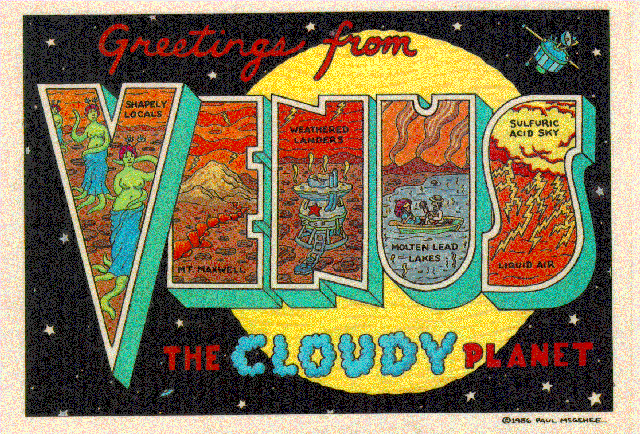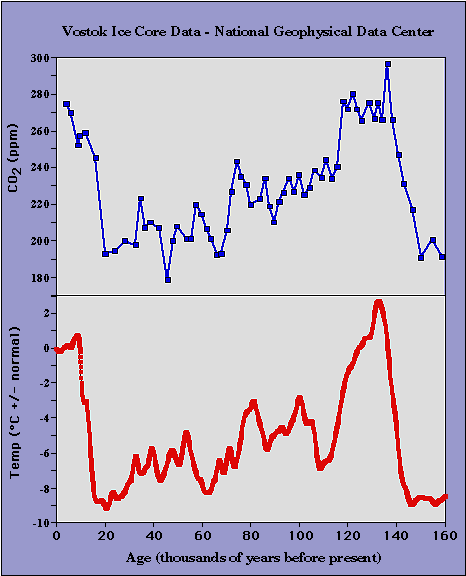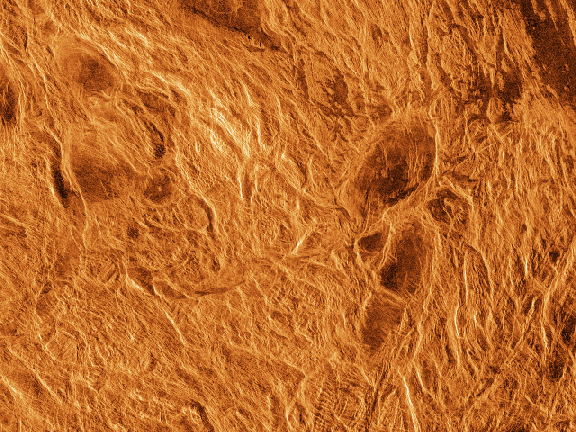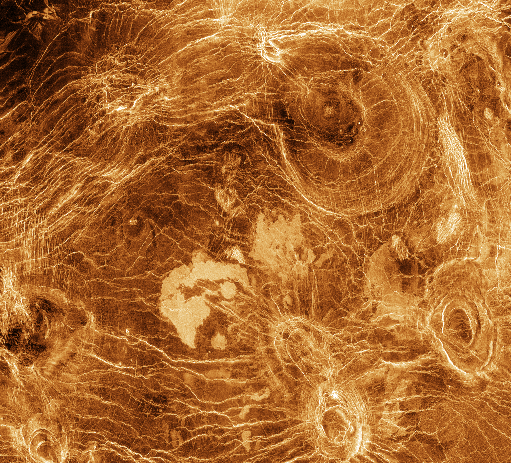

Venus:
Venus is a primary feature of the night sky, and so has been of remarkable importance in mythology, astrology and fiction throughout history and in different cultures. Classical poets such as Homer, Sappho, Ovid and Virgil spoke of the star and its light. Romantic poets such as William Blake, Robert Frost, Alfred Lord Tennyson and William Wordsworth wrote odes to it. With the invention of the telescope, the idea that Venus was a physical world and possible destination began to take form. Venus was once know by ancient astronomers as the morning star and evening star due to its low elongation with respect to the Sun. Venus, which is named after the Roman goddess of love and beauty, is veiled by thick swirling cloud cover. Due to its closeness to the Sun, Venus was once thought to be two planets, Hesperus (evening star) and Phosphorus (morning star).
The impenetrable Venusian cloud cover gave science fiction writers free rein to speculate on conditions at its surface; all the more so when early observations showed that not only was it similar in size to Earth, it possessed a substantial atmosphere. Closer to the Sun than Earth, the planet was frequently depicted as warmer, but still habitable by humans, tropical. The genre reached its peak between the 1930s and 1950s, at a time when science had revealed some aspects of Venus, but not yet the harsh reality of its surface conditions. Findings from the first missions to Venus showed the reality to be quite different, and brought this particular genre to an end. As scientific knowledge of Venus advanced, so science fiction authors tried to keep pace, particularly by conjecturing human attempts to terraform Venus.
Venus is shrouded by an opaque layer of highly reflective clouds of sulfuric acid, preventing its surface from being seen from space in visible light. It may have had water oceans in the past, but these would have vaporized as the temperature rose due to a runaway greenhouse effect. The water has probably photodissociated, and the free hydrogen has been swept into interplanetary space by the solar wind because of the lack of a planetary magnetic field. Venus's surface is a dry desertscape interspersed with slab-like rocks and is periodically resurfaced by volcanism.
Venus is often called the twin planet to Earth because 1) it has a similar radius/size, 2) is has a similar mass, 3) it has a similar density and 4) it has an atmosphere. However, the environment of Venus is very different from the Earth, its ground temperature is over 800 degrees F and its atmosphere is carbon dioxide and sulfuric acid. Venus, thus, is less of a twin and more of a cautionary tale for what happens to a world with a massive greenhouse effect and runaway climate change.

cloud cover
The above image of Venus is a mosaic of three images acquired by the Mariner 10 spacecraft on February 5, 1974. It shows a heavy atmosphere covered with thick clouds that prevents optical observation of the surface of Venus.

radar mapped terrain
This hemispheric view of Venus is the result of more than a decade of radar investigations culminating in the 1990-1994 Magellan mission. The effective resolution of this image is about 3 kilometers. It was processed to improve contrast and to emphasize small features, and was color-coded to represent elevation.

Radar imaging shows that a Venusian day is 243 Earth days and is longer than its year of 225 days. Oddly, Venus rotates from east to west. To an observer on Venus, the Sun would rise in the west and set in the east.

Venusian atmosphere:
Venus has an extremely dense atmosphere composed of 96.5% carbon dioxide, 3.5% nitrogen, and less than 1% of O2, H2O and CH4 (methane) and traces of other gases, most notably sulfur dioxide. The mass of its atmosphere is 93 times that of Earth's, whereas the pressure at its surface is about 92 times that at Earth's, a pressure equivalent to that at a depth of nearly 1 kilometre (0.62 mi) under Earth's oceans. The density at the surface is 65 kg/m^3, 6.5% that of water or 50 times as dense as Earth's atmosphere at 293K (20C; 68F) at sea level. The CO2-rich atmosphere generates the strongest greenhouse effect in the Solar System, creating surface temperatures of at least 735 K (462 C; 864 F). This makes Venus's surface hotter than Mercury's, which has a minimum surface temperature of 53 K (220 C; 364 F) and maximum surface temperature of 693 K (420 C; 788 F), even though Venus is nearly twice Mercury's distance from the Sun and thus receives only 25% of Mercury's solar irradiance. This temperature is higher than that used for sterilization. The surface of Venus is often said to resemble traditional accounts of Hell.
Understanding the pressure, density and temperature of an atmosphere means understanding the Ideal Gas Law. The Ideal Gas Law states that the pressure, density and temperature of a gas are all related by a simple formula. For example, if you increase the pressure of a gas, its temperature also goes up or its density goes down. If you lower the density, the pressure goes down or the temperature goes up. The formula to express this relation is:
where ρ is the density (in gm/cc), T is the temperature (in Kelvins), P is the pressure (in bars), N is Avagadro's number (a constant) and k is Boltzmann's constant. Since there are two constants and three variables, it is often useful to express the ideal gas law as the ratio of the values. So, for example, the pressure, density and temperature of two planets' atmospheres (planet 1 and planet 2) are expressed as:
There are two types of greenhouse effects, normal and enhanced. Normal greenhouse is a natural activity that all the Terrestrial planets with atmospheres undergo (Venus, Earth and Mars). Both types are based on the property that some types of gases will absorb short wavelength light (visual) and remit it as long wavelength IR (heat).


Enhanced greenhouse effect is when the natural greenhouse gases are added by by human activity. Important components are CFC's and N2O from fossil fuels. Is this real? Is there any evidence that human civilization has changed the biosphere? The following plot indicates that we are nearing an all-time record in temperature and CO2 abundance based on ice core samples (note the upward trend starts 20,000 years ago when humans began to modify the environment).

The enhanced greenhouse effect is a complicated political issue. There are numerous popular misconceptions. For example, it is a misconception that the destruction of the Amazon rainforest contributes to the enhanced greenhouse effect. It does not, rainforest are mostly greenhouse gases producers. It is the total biomass on the planet that is important, and agriculture has filled in much of the holes that cities and population have taken.
What are the results of an enhanced greenhouse effect?
Venusian Surface Features:
Due to an optically thick atmosphere, the surface features on Venus are known only through radar mapping. Venus' surface is relatively young geologically speaking. It appears to have been completely resurfaced 300 to 500 million years ago. It's not clear how and why this occurred. About 80% of the Venusian surface is covered by smooth, volcanic plains, consisting of 70% plains with wrinkle ridges and 10% smooth plains. Two highland "continents" make up the rest of its surface area, one lying in the planet's northern hemisphere and the other just south of the equator. The northern continent is called Ishtar Terra after Ishtar, the Babylonian goddess of love, and is about the size of Australia. Maxwell Montes, the highest mountain on Venus, lies on Ishtar Terra. Its peak is 11 km (7 mi) above the Venusian average surface elevation. The southern continent is called Aphrodite Terra, after the Greek goddess of love, and is the larger of the two highland regions at roughly the size of South America. A network of fractures and faults covers much of this area.
Some of the prominent features revealed by the Magellan mission are:

1) Craters - impact craters, Venus is scarred by numerous impact craters distributed randomly over its surface. Small craters less that 2 kilometers are almost non-existent due to the heavy Venusian atmosphere. The exception occurs when large meteorites shatter just before impact, creating crater clusters. Note the lava flows around the rims.

2) Volcanoes - Volcanic features are common on Venus with at least 85% of the Venusian surface is covered with volcanic rock. Hugh lava flows, extending for hundreds of kilometers, have flooded the lowlands creating vast plains. More than 100,000 small shield volcanoes dot the surface along with hundreds of large volcanoes. Flows from volcanoes have produced long sinuous channels extending for hundreds of kilometers, with one extending nearly 7,000 kilometers.
The absence of evidence of lava flow accompanying any of the visible calderas remains an enigma. The planet has few impact craters, demonstrating that the surface is relatively young, approximately 300-600 million years old. Venus has some unique surface features in addition to the impact craters, mountains, and valleys commonly found on rocky planets. Among these are flat-topped volcanic features called "farra", which look somewhat like pancakes and range in size from 20 to 50 km (12 to 31 mi) across, and from 100 to 1,000 m (330 to 3,280 ft) high; radial, star-like fracture systems called "novae"; features with both radial and concentric fractures resembling spider webs, known as "arachnoids"; and "coronae", circular rings of fractures sometimes surrounded by a depression. These features are volcanic in origin.

3) Fault lines - In images of the Alpha Regio, bright terrain is shown to be a series of troughs, ridges, and faults that are oriented in many directions. The lengths of these features generally range from 10 kilometers to 50 kilometers.

4) Arachnoids - As the name suggests, arachnoids are oval features with concentric rings and a complex network of fractures extending outward. The arachnoids range in size from approximately 50 kilometers to 230 kilometers in diameter. They might have resulted from an upwelling of magma from the interior of the planet which pushed up the surface to form "cracks".
Although there is no direct evidence for tectonic activity (active volcanoes, plumes, vents, etc.), three of the above features suggest weak geological activity in the last 107 years. Much of the Venusian surface appears to have been shaped by volcanic activity. Venus has several times as many volcanoes as Earth, and it has 167 large volcanoes that are over 100 km (62 mi) across. The only volcanic complex of this size on Earth is the Big Island of Hawaii. This is not because Venus is more volcanically active than Earth, but because its crust is older. Earth's oceanic crust is continually recycled by subduction at the boundaries of tectonic plates, and has an average age of about 100 million years, whereas the Venusian surface is estimated to be 300-600 million years old.
Venusian Soil:
Due to the intense heat and pressure, a mission to the surface of Venus was challenging. The Venera missions were a series of unmanned Soviet planetary probes that were sent to Venus. Venera 5 and 6 (1969) made soft landings on Venus, but ceased transmitting data before reaching the surface because of the extreme heat and pressure. Venera 9 and 10 (1975) sent back the first closeup photographs of the planet's surface; these images showed that certain parts of Venus were covered with sizable sharp-edged rocks and others with fine-grain dust.

In general, the Venusian soil is rocky material intermixed with gravel. The rocks appear to be igneous in nature and smooth from erosion.
Venus Internal Structure:
Without seismic data or knowledge of its moment of inertia, little direct information is available about the internal structure and geochemistry of Venus. The similarity in size and density between Venus and Earth suggests they share a similar internal structure: a core, mantle, and crust. Like that of Earth, the Venusian core is at least partially liquid because the two planets have been cooling at about the same rate. The slightly smaller size of Venus means pressures are 24% lower in its deep interior than Earth's. The principal difference between the two planets is the lack of evidence for plate tectonics on Venus, possibly because its crust is too strong to subduct without water to make it less viscous. This results in reduced heat loss from the planet, preventing it from cooling and providing a likely explanation for its lack of an internally generated magnetic field. Instead, Venus may lose its internal heat in periodic major resurfacing events.

|
|

|